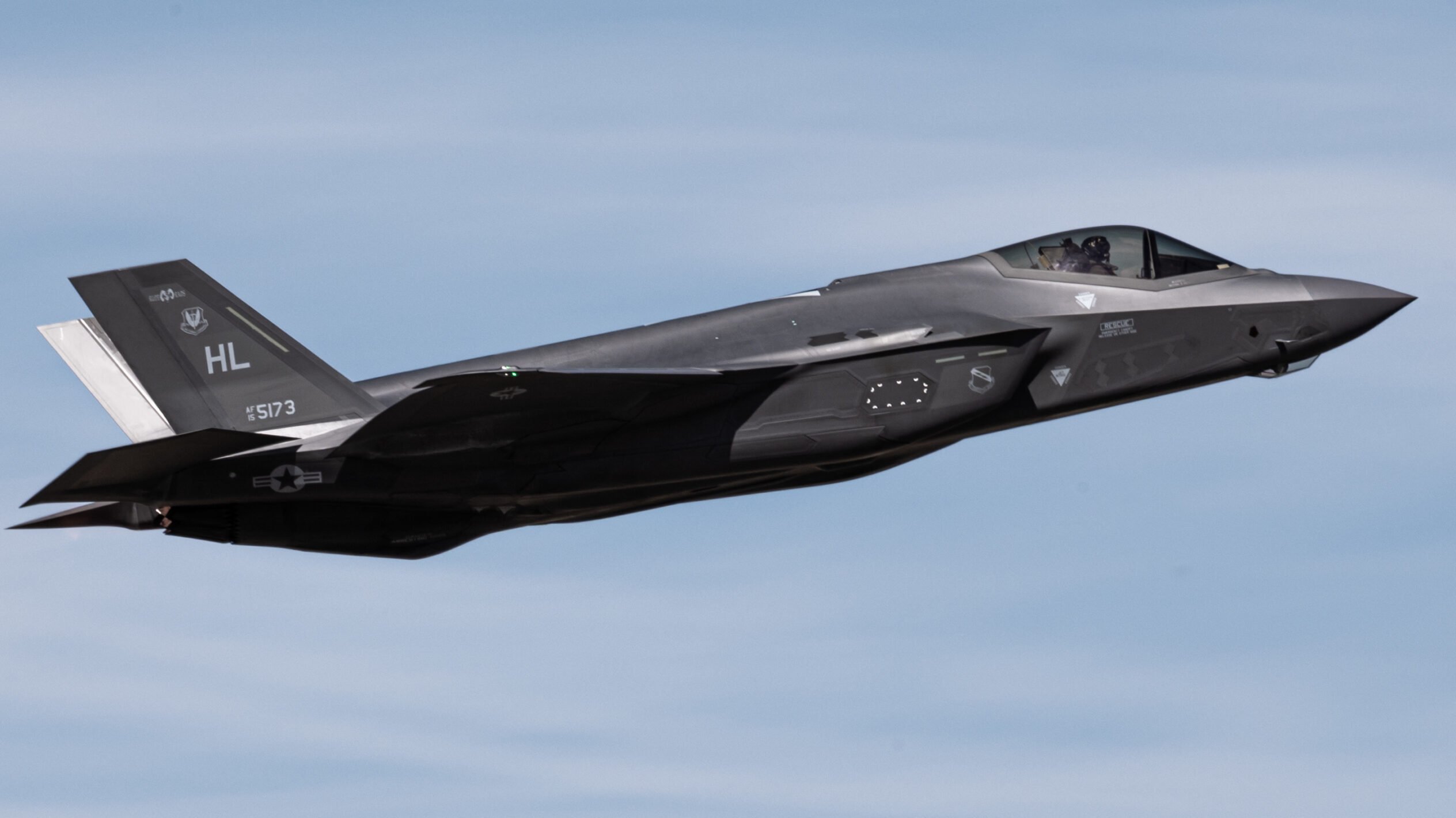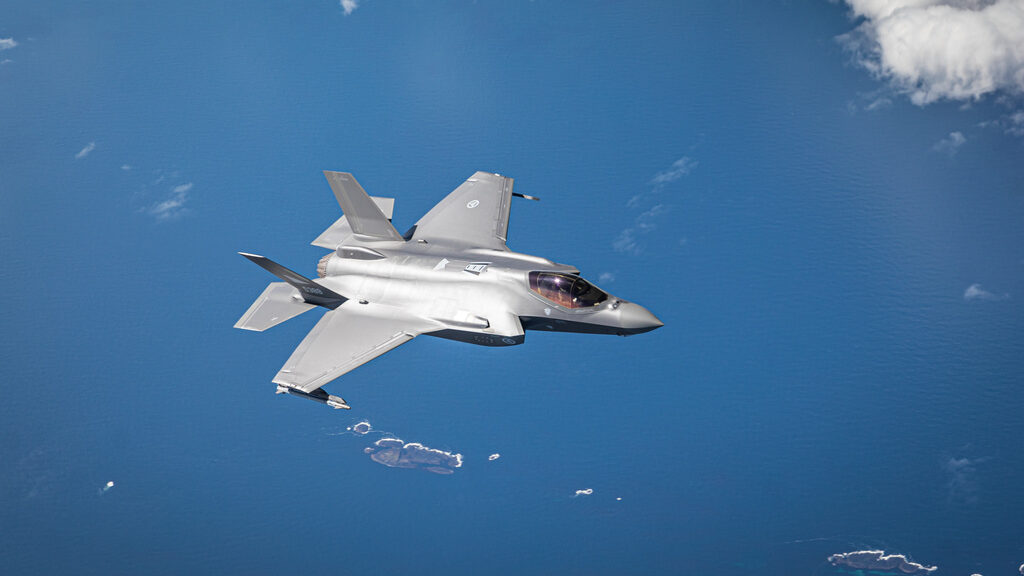
An F-35A Lightning II assigned to the 388th Fighter Wing takes off for the Utah Test and Training Range for a training mission at Hill Air Force Base, Utah, May 13, 2021. (U.S. Air Force photo by Capt. Kip Sumner)
WASHINGTON — The Defense Department is considering “all” options as it seeks upgrades to the F-35’s cooling system, Breaking Defense has learned, with the F-35 Joint Program Office not ruling out the potential for a new competition to upgrade the system currently provided by incumbent producer Honeywell Aerospace.
Honeywell makes the F-35’s Power and Thermal Management System, or PTMS, which combines an auxiliary power unit, environmental control and emergency power into a single apparatus that, among other capabilities, cools off the aircrafts subsystems. The F-35 Joint Program Office (JPO) wants to upgrade the PTMS in order to enable future capabilities on the fifth-generation aircraft.
Asked directly by Breaking Defense whether the F-35 program is planning a competition to field a new PTMS, JPO spokesman Russ Goemaere on Thursday said “All PTMS options will be assessed to ensure we provide the greatest capability to the warfighter.”
He then added that officials “are very early into the Defense Acquisition System/Process. However, as a first step a PTMS Modernization Industry Day was held on 12-14 June with industry to collect market research, design solutions and insight on what will be needed to ensure the successful development of a new PTMS solution.”
The JPO statement is the closest yet the office has come to stating that a full-on recompete for the PTMS is on the table. And it comes as Honeywell is crying foul that its primary challenger may have an unfair advantage in a potential competition — with the Pentagon wary of providing a remedy the company seeks.
Honeywell’s goal is to have greater access to data on Pratt & Whitney’s Engine Core Upgrade (ECU). Officials are exploring improvements to the F-35’s PTMS alongside the fighter’s engine — opting to upgrade Pratt’s current F135 powerplant through the ECU program — to head off future cooling and power challenges. The program expects to field a dual PTMS/ECU modernization by 2030, the JPO has previously said.
The engine and PTMS work together to cool off the F-35, and the JPO has said modernizing both must be done in tandem to optimize their respective designs.
“In the best interest of the taxpayers and the best interest of reducing costs, and providing availability and capability for Block 4, we should have the ECU requirements being fed over to [the] PTMS because we’re already on there. We can take advantage of [that] and provide the lowest cost solution and meet the immediate threats for Block 4” and other future upgrades, Matt Milas, Honeywell’s president for defense and space, said in a July interview.
Milas also emphasized that Honeywell’s PTMS is meeting the requirements that were set forth for it. As highlighted in recent watchdog reports, Honeywell’s PTMS has needed to pull more bleed air off the F135 than specifications originally called for. That relationship has caused the engine to run hotter, prompting officials to seek upgrades to both companies’ systems especially as increased cooling needs will be brought on by upgrades down the road.
“The Program continues to evaluate technical risks and opportunities relative to PTMS. The Government appreciates Honeywell’s contributions to, and interest in continuing, supporting the Program,” Goemaere said when asked about Honeywell’s request. “Maintaining acquisition integrity at this stage, however, requires discretion when engaging with any individual vendors, so as not to prejudice opportunities for wider industrial participation.”
Collins Lining Up As Prime Competition
A competition to replace the current PTMS could put significant heat on Honeywell, whose design would be at risk of getting knocked out by a competitor. One opponent is already known: RTX subsidiary Collins Aerospace announced at the Paris Air Show plans to offer a new PTMS, dubbed the Enhanced Power and Cooling System (EPACS), which company officials said will be ready for an engineering and manufacturing development phase next year.
It’s unknown if others may seek to participate in a PTMS competition. However, both Collins and Pratt are owned by RTX, which adds a level of tension over Honeywell’s desire to get extra information out of Pratt.
For its part, Lockheed Martin, the prime contractor for the F-35, said in a statement that the company stands behind the JPO’s ongoing analysis, including the possibility of incorporating new designs.
“We are fully committed to engine, cooling, and power modernization efforts that ensure the F-35 remains the world’s most capable fighter for decades to come,” the company said in a statement to Breaking Defense. “We are supporting the F-35 Joint Program Office with their requirement definition, assessment of life, performance and life cycle costs of the propulsion options and cooling/power configurations including baseline systems, upgrades to that baseline and new architecture designs.”

A Royal Norwegian Air Force F-35 fighter jet flies over Norway (Norwegian Armed Forces)
Previously, RTX subsidiaries Pratt and Collins have touted their respective ECU and EPACS designs as complementary, which when combined would deliver extensive margin for growth on the F-35. In January, RTX championed the two systems working together in a news release.
For Milas, the public-facing statements about the collaboration is evidence of impropriety and, in his eyes, an attempt by RTX to knock Honeywell off the PTMS and bring all that work in-house.
Asked whether he thought Pratt was withholding information on the ECU for a competitive advantage, Milas replied, “I’d say anybody who’s really interested in the best interest of the program and best interest of taxpayer money, would want to share that information openly with the current PTMS provider. For them to say that [the ECU] meets the capabilities and not working with us, that tells you something,” adding that he is “extending the arm of collaboration to work together and try to find that solution for the lowest cost possible.”
In response to Milas’s comments, Jen Latka, vice president for F135 programs for Pratt, said in a statement: “We are not denying Honeywell information on our Engine Core Upgrade. We have not received any requests for information on ECU through official channels, and that makes sense because the JPO asked us mid-June 2023 not to share any information on ECU with potential PTMS providers because it could turn into a competitive effort.
“Based on this request, Pratt immediately developed and implemented a mitigation plan that includes firewalls between our Pratt ECU and Collins EPACS teams to avoid conflicts of interest. We respect the JPO’s desire for a fair competition on PTMS, and any requests for information on ECU should be directed to them,” she added.
Honeywell’s Argument: High Cost, Risk of Replacement
To boost Honeywell’s own offering for the PTMS, Milas turned to arguments employed by Pratt in support of its ECU approach — namely, that retrofitting jets with a new PTMS would cost billions and introduce developmental risk.
“I think it’s going to be [an] over $2 billion cost impact to switch out the PTMS, and I don’t think that the JPO or the program or the partner countries are really interested in paying that bill. I think that they’d like to see the JPO and like to see us partners working together to find the most affordable solution that meets the needs of the aircraft,” he said.
When asked about the possibility of a competition for a new PTMS, Milas replied, “If there was to be a competition and introduce an entirely new architecture, I can assure you that there will be problems and there will be challenges that are encountered as with any new development type of program. And I think that just introduces more risk and more cost to the F-35.”
Losing out on a competition for a PTMS upgrade would be a setback for Honeywell, though the company would still remain intimately involved in the F-35 program: Honeywell currently makes some 100 parts for the stealth fighter, such as its brakes and wheels.
Milas said the company is currently engaged with Lockheed on “trade studies and design alternatives,” and in the near term has developed what he called a “modest” PTMS upgrade that will offer “a couple kilowatts” in cooling capacity, which he said the program is aiming to qualify by mid-2024.
In the longer term to accommodate future cooling needs, with analysis funded both internally and by Lockheed, Honeywell is further evaluating other major PTMS improvements. Some of those improvements, Milas said, would feature new tech like micro-vapor cooling systems, advanced materials, modernized coatings and 3-D printed parts.
But there are changes that should be made on the aircraft as well that are separate from the PTMS, Matt Schacht, Honeywell’s VP for engineering, emphasized in a July 25 interview.
“Some of that is work on the PTMS itself to unleash that extra cooling capacity, but a significant portion of adding cooling capacity on the aircraft is having additional heatsink [ability] to be able to make the thermodynamic cycle work,” Schacht said.
He then explained that there are two heatsinks on the F-35: fan duct heat exchangers supplied by Honeywell and the fighter’s fuel thermal management system, which he said is “owned by and integrated by Lockheed Martin.
“And so any future growth capacity will need changes to one or both of those systems,” he added.
The need for Lockheed, Pratt, the eventual PTMS provider and the JPO to sync up various subsystems is a key reason Honeywell is pushing for greater collaboration now, Milas said, adding that the sooner the program makes a decision on the PTMS, the better the F-35 will fare.
“I think the sooner that we can get to that type of answer then the sooner we can get the investments and the capabilities out there to support Block 4 and be able to meet that… timeline to 2030,” he said.
In fiery speech, Aussie defense chief urges support for ‘extraordinary’ AUKUS subs
Gen. Angus Campbell also defended the conduct of the Australian military after a recent run-in with Chinese helicopters.


























